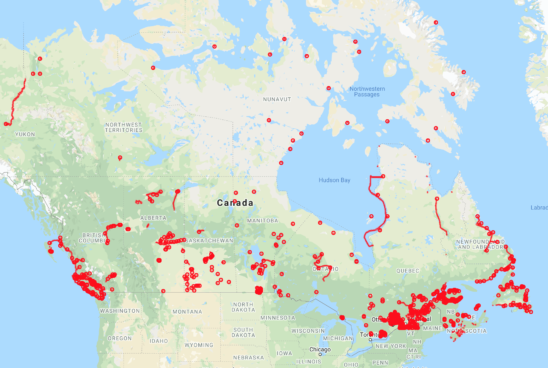
Policy
Many commentators have raised the question of inequity due to lack of Internet coverage. So what actually is the coverage like in Canada?
According to the Canadian Radio-Television and Telecommunications Commission (the CRTC), the federal agency that regulates and supervises broadcasting and telecommunications in the public interest:
Whether you’re at home, at work, or on the road, your phone should be able
If you have this kind of bandwidth into the home (and appropriate equipment, such as a modem, computer or tablet), there should be no technical issues in studying online (so long as you can afford the carriers’ fees).
Implementation
That’s the policy; what about the implementation? Again, according the CRTC, with regard to Internet access:
- 86% of the Canadian population have this targeted level of access
- however, less than half (41%) of those living in rural communities have this targeted level of access
- and in First Nations reserves only 28 per cent have this targeted level of access.
Mobile LTE access covers:
- 99% of all Canadians
- 96.5% of all rural communities
- 87% of all major road and highways.
However, while mobile phones are useful for some online learning applications, they are not suitable for supporting extensive use of online learning, in terms of cost, bandwidth and ergonomics (screen size, keyboarding) – at least not for anyone over 30 years old!
Especially in the far north, there is satellite coverage, but this is usually no more more than 2Mbps download speed and even slower upload speeds, barely enough for voice communication and email.
So what about those without adequate coverage?
There’s a plan!
It should be remembered that Canada is a very large country geographically (the second largest land mass in the world). What is more, two-thirds of the population live within 100 kilometres of the U.S. border (to stop the Americans invading, or to be close to where the real money is, depending on your view). This means that there are relatively few people scattered over a huge area, which is not how telecommunications companies would like countries to be designed.

Nevertheless, in 2019, the Federal government announced a $6 billion plan to invest in expanding high-speed Internet to all Canadians. It even set targets:
- 95% covered by 2026
- 100% by 2030.
Even in 2019, these targets were criticised by several experts as being too far away, given the importance of the Internet to Canada’s economy. Since then, others have criticised the slow rate in which the money has been rolled out. Applications are still open for the Broadband Fund today.
In the meantime, both the three large and the few smaller Canadian telecommunications companies have been gradually increasing their coverage of rural areas, using fixed wireless technology to relay from the nearest fibre optic terminals, although so far fixed wireless stations usually support only 25 Mbps download speeds, but may be good enough for most online learning, so long as the course designers work to that limit, until fixed wireless technology improves – as it will.
Conclusion
Canadians overall are fortunate to have relatively good Internet access, although there are still significant gaps, especially in First Nations reserves and other rural areas. Even here, there is some hope that things will improve over the next five to ten years. So in general, in technical terms, online, home-based learning is feasible for the vast majority of Canadians.
However Covid-19 has highlighted the problems of inadequate Internet coverage for a small but significant minority, and the crisis should provide an impetus for speeding up adequate Internet coverage for all Canadians.









 Dr. Tony Bates is the author of eleven books in the field of online learning and distance education. He has provided consulting services specializing in training in the planning and management of online learning and distance education, working with over 40 organizations in 25 countries. Tony is a Research Associate with Contact North | Contact Nord, Ontario’s Distance Education & Training Network.
Dr. Tony Bates is the author of eleven books in the field of online learning and distance education. He has provided consulting services specializing in training in the planning and management of online learning and distance education, working with over 40 organizations in 25 countries. Tony is a Research Associate with Contact North | Contact Nord, Ontario’s Distance Education & Training Network.


I think the issue with LTE is less screen size and more cost. Less screen size because tablets and even laptops can be ‘tethered’ to LTE access using mobile hotspots. But more cost because mobile internet rates in Canada are among the highest in the world, and even at these rates there are low data caps. These combined mean that we could not use what might otherwise be decent connectivity for rural areas for any serious purpose.